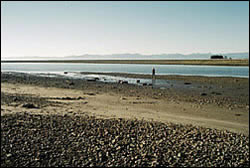Ecosystem models of Tasman & Golden Bays
Research Status: Ongoing |
Looking across Tasman Bay |
Introduction
Sustainable management of the coastal environment of Tasman Bay is the primary driver for research. The ultimate aim of environmental studies is to develop the ability to predict ecosystem responses to particular events. This can be achieved through the use of predictive models.
The work presently underway in the Motueka ICM programme involves acquiring data describing inflows and ecosystem responses in Tasman Bay. Analyses of these data will reveal functional relationships between events and responses. In other words, a conceptual model of how marine communities in the Bays respond to different events will be determined. For example, it is likely that inflows from the major rivers in the catchments of Tasman and Golden Bays act as a pathway for nutrients to enter the coastal food web. The waters of the Bays are often nutrient depleted, hence additional nutrients from terrestrial sources are likely to result in added biological productivity. The response of suspended phytoplankton and seafloor benthic microalgae is difficult to predict without some understanding of the dominant ecological processes occurring in the Bays. However, these relationships are complex and the result of intricate interrelationships. In most cases a complex numerical model is required in order to aid in unravelling these relationships. Modelled relationships determined for Tasman Bay will also provide insights to catchment implications for the adjoining Golden Bay river plume ecosystems. The model predictions can also be used to guide management of aquaculture management areas that are`positioned within plume-affected areas.
Research Approach
A coupled hydrodynamic circulation and ecosystem model will be configured for the Tasman Bay. The application of the generic models can be performed relatively quickly. However, a significant level of effort is required to incorporate the relationships derived from analyses of the data into the modelling system. Once this has been performed the model must be validated against the known behaviour of the Bay.
Research Results
The major output of this project would be a working, validated ecosystem model of Tasman Bay. This model could be used to elucidate the response of the river plume ecosystem to particular environmental events, for example terrestrial inflows. An additional output would be an operational forecasting system able to predict the response of the Nelson Bays to predicted events.
 |
 |
Delta sampling |
Paul Gillespie discussing coastal issues at Puketawai |
Recent Publications
Recent Presentations
BMPs, BEPs and Guidelines
| Title | Description |
| Tonga Island Marine Reserve: Proposed protocol for ongoing subtidal biological monitoring | This document presents a proposed protocol for ongoing monitoring of the Tonga Island Marine Reserve...More » |
Primary Contacts:

|
Chris Batstone
Email More details» |
Institute Cawthron Institute |
Expertise resource economics |

|
Paul Gillespie
Email Phone: 03 548 2319 Fax: 03 546 9464 |
Institute Cawthron Institute |
Expertise Estuarine & marine microbial ecology |

|
Ben Knight
Email More details» |
Institute Cawthron Institute |
Expertise Biophysical systems specialist |